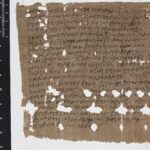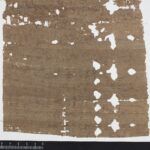| Artefact ID | 147 |
| TM ID | TM 21126 |
| Findspot (DEChriM ID) | 58 (Dayr al-ʿIẓām) | Class | Textual |
| Material | Papyrus |
| Writing medium | Sheet/roll |
| Text content | Documentary |
| Language | Greek |
| Archive/Dossier | Archive |
| Description | P.Herm. 7: Letter to Apa John. A certain Psois, son of Cyllus from the village of Pouchis in the Antaeopolite nome, asks his "master, the beloved Apa Iohannes" to write a letter to Psois from Toeto, ex-tribune, to arrange to have him exempted from army service by reason of his finger – probably cut off to be disqualified for service (Zuckerman 1995: 184-187). Recto: text along the fibres. Verso: address (to the "anachoretes Iohannes"), along the fibres.
P.Herm. 7 is one of many Greek and Coptic letters addressed by monks, clerics, soldiers, state officials and individuals to Apa John, so that he would intercede in their favour in dealings with the authorities or pray for them. Zuckerman 1995 identified the anchorite of this archive with the famous John of Lycopolis known from literary sources. A striking feature of this text is the abnormally large number of mistakes typical of Egyptians with poor Greek skills. Since Apa Iohannes was also Egyptian, one wonders why Psois made the effort to write in Greek. J.-L. Fournet (2020: 56) recently suggested as an explanation the fact that "as the language of administration and of the Church, Greek seemed to be a requirement for the 'petition' that he was going to submit to the holy man". For a new edition, translation and commentary of this letter, see Fournet 2020: 50-57. |
| Selection criteria | Mention of Christian individuals/communities, Christian terms/formulas/concepts |
| Date from | 381 |
| Date to | 400 |
| Dating criteria | This letter has been connected to the archive of Apa John of Lykopolis (ca. 375-400). According to C. Zuckerman, the circumstances described in this particular text have to be situated soon after Theodosius' law of September 381 regarding the recruitment procedures (Zuckerman 1995: 184). |
| Absolute/relative date | Relative date |
| Archaeological context | According to Constantine Zuckerman's reconstruction, the Apa John’s letters were presumably found in September 1897, during the excavations of Farag Ismael and Yassa Tadros on the mountain of Siout (Lykopolis), in the ruins of Dayr al-ʿIẓām, the site of the monastery of John of Lycopolis. Yet they never reached the museum in Gizeh – like the other objects unearthed during these excavations – and must have ended on the market, where they were bought soon after the excavations (Zuckerman 1995: 191-192; Van Minnen 1994: 80-82, Gonis 2008: 69-72). Although not proven, this attractive hypothesis is generally accepted by scholars (see discussion in Van der Vliet 2015: 166-167, and some reservations in Choat 2017: 37-40). |
| Accession number | Manchester, John Rylands Library, P.Herm. 7 |
ARTEFACT IDENTIFIERS
Editio princeps:
• Rees, Brinley R. 1964. Papyri from Hermopolis and Other Documents of the Byzantine Period. Egypt Exploration Society, Graeco-Roman Memoirs 42. London, no. 7.
Additional bibliography:
• Choat, Malcolm and Maria Chiara Giorda. 2017. Writing and Communication in Early Monasticism. Texts and Studies in Eastern Christianity 9. Leiden, Boston, 37-40, 54, 60.
• Fournet, Jean-Luc. 2020. The Rise of Coptic: Egyptian Versus Greek in Late Antiquity. The Rostovtzeff Lectures Book 1. Princeton, 13-14; 50-57.
• Gonis, Nikolaos. 2008. “Further Letters from the Archive of Apa Ioannes.” Bulletin of the American Society of Papyrologists 45, 69-85.
• Van der Vliet, Jacques. 2015. “Snippets from the Past: Two ancient sites in the Asyut Region: Dayr al-Gabrawi and Dayr al-’Izam.” In Christianity and Monasticism in Middle Egypt, ed. Gawdat Gabra and Hany Takla. Cairo: The American University in Cairo Press, 161-168.
• Van Minnen, Peter. 1994. “The Roots of Egyptian Christianity.” Archiv für Papyrusforschung und verwandte Gebiete 41, 71-85.
• Zuckerman, Constantine. 1995. "The Hapless Recruit Psois and the Mighty Anchorite, Apa John." Bulletin of the American Society of Papyrologists 32, 183-194.


 Json data
Json data





